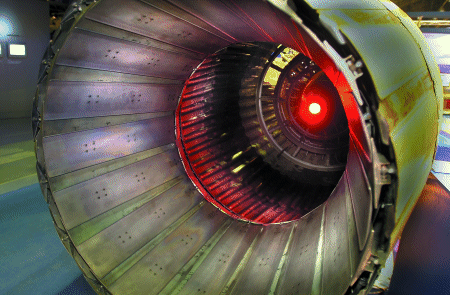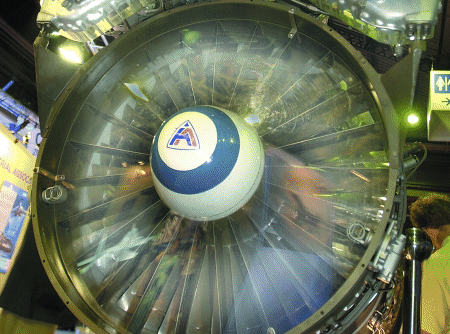As Russia's top engine-making trio merge to form NPO Saturn, a fifth-generation engine is its top priority
Vladimir Karnozov / Moscow
Creating an internationally competitive fifth-generation engine is arguably the most critical aspect of developing Russia's next generation fighter. The aircraft is needed to secure Russia's position on the international combat aircraft market. And once the upcoming merger of Russia's three wealthiest engine makers is completed, creating the fifth-generation engine will be the trio's top priority, says Victor Chepkin, the man selected to head the soon-to-be formed company.

Rybinsk Motors, A Lyulka-Saturn and Ufa Engine Building Association (UMPO) are amalgamating into a new company to be known as the Saturn Scientific Industrial Association (NPO Saturn), a process expected to take about six months. The merger, announced in April after three years of talks, will result in a powerful manufacturer whose 30-40,000 strong workforce will develop and produce power plants for military and civil aircraft, rockets, power stations, gas pumping units, cars, trucks, tractors and snow vehicles.
When NPO Saturn is established, Chepkin, who now serves as A Lyuka-Saturn general designer, will in his new role oversee one of Russia's most powerful research and development (R&D) structures, employing 10,000 specialists in Moscow, Rybinsk and Ufa.
Today the share of foreign orders in Russia's combat aircraft business stands at 70-90%. Russia's weapons sales are estimated at $4 billion per annum, half of from the export of Sukhoi and RSK MiG fighters. There is growing understanding in the industry, however, that failing to invest heavily in the creation of new high-technology products will lead to a diminished role in the international market over the next 10-15 years - the development and sales potential of Su-27 and MiG-29 fighters will have been exhausted.
Although creating the fifth-generation aircraft engine tops the list of priorities for NPO Saturn, Chepkin says other issues play a role in favouring the merger - such as needing to reduce manufacturing costs, and offering a more effective worldwide after-sales support system for aircraft engines and industrial turbines. The largest percentage of A Lyulka-Saturn and UMPO current income is generated by sales of the AL-31 engine and its derivatives, and their after-sale support.

China and India, the largest foreign customers for Sukhoi fighters, have taken delivery or placed orders for almost 500 twin-engine Su-27 Flankers, powered by the AL-31. Approximately the same number of such fighters are in service in the CIS, Southeast Asia and Africa. This creates a huge maintenance and upgrade market, and hence the need to keep the AL-31 at the level of modern requirements.
Chepkin believes this can be best achieved by bringing together the engine developer (A.Lyulka-Saturn) and manufacturer (UMPO) under one structure.
Integration
UMPO general director Valery Lisunov agrees: "Development of a fifth-generation engine and fulfillment of the large foreign orders for the fourth-generation engines requires the uniting of intellectual, technological and industrial resources of all enterprises involved in those programmes, especially in view of a considerable drop in production which we had in the early 1990s." As the life cycle of a basic engine is 30-40 years, it is impossible to market a new engine in a highly competitive environment without the ability to convince customers that an effective support system is in place for newly-built and in-service engines, he adds.
Both Chepkin and Lisunov emphasise that NPO Saturn shall not be "just another club", but an effective company with rigid control from top to bottom. It will be a joint stock organisation with a large state interest (around 40%) governed by a control board. "The control structure will be similar to that of RAO Gazprom, which is headed by the chairman of the control board," Chepkin says. Such a system will help reduce the influence that top managers' personal relationships can exert on business activities. Privately, this is seen as especially important in view of the negative role personal conflicts have allegedly played in the history of Sukhoi and MiG's industrial associations.
One goal of the merger is product diversification to attain greater market stability. Only half of NPO Saturn's production output is intended to be aircraft engines, the other half being industrial turbines and drives for various ground applications. Building on the AL-31's successful use on combat aircraft, A Lyulka-Saturn has developed a large number of derivatives for ground applications; for example, the engine's core is widely used in industrial turbines and gas pumping units.
The latter are in great demand, with RAO Gazprom alone needing 100 units a year. Power turbines in the 12-20 mW class are also popular because they provide an alternative to centralised nationwide power supply systems, offering lower prices (by 8-10%) and more flexibility in use. Parts commonality between ground turbines and aircraft engines is about 70%, Chepkin says.
China, India, Malaysia and United Arab Emirates are viewed as promising markets for industrial turbines, and A.Lyulka-Saturn and UMPO are bidding jointly in China on a tender for several hundred gas-pumping units. Their proposal is based on products developed from the AL-31F engine in service on Chinese air force Su-27SK, UB and Su-30MKK fighters. The Chinese have mastered repair and maintenance of the engines, and the Russians are ready to involve Chinese industry in producing the powerplants.
The Russian engine makers are looking for further co-operation with foreign companies in producing aircraft engines and power turbines. Indian participation in the fifth-generation aircraft engine project is being discussed, Chepkin says.
India is also a potential partner in the fifth-generation fighter programme. The intention is to mitigate development costs so that the aircraft can compete on the international market with the Joint Strike Fighter (JSF). If India or other countries become involved in the Russian programme, then the foreign partners could also become involved in development and production of the accompanying engine.
The Russian competitor to the JSF, should it ever be developed, is likely to have a single AL-41F engine developed by A.Lyulka-Saturn. The AL-41F development began over 15 years ago. In 1987-88 experimental examples were tested on Tupolev Tu-16 Badger and Miloyan MiG-25 testbeds at supersonic speeds. Two experimental engines power the RSK MiG 1.42 technology demonstrator built in the frame of the defunct MFI (Multifunctional Frontline Fighter) project.
Parts for over a dozen engines were made at A.Lyulka-Saturn's experimental factory before 1998, when the firm reached agreement with Rybinsk Motors on setting up a production line.
All major design solutions on the engine as a thrust producers have been worked out, tested and approved by the ministry of defence, Chepkin says.

Nearing completion
The revised published specification details the requirements. "We hit the bull's eye with the AL-41," Chepkin says, noting that the engine may have been conceived over 15 years ago, but requires only minor improvement to meet the revised specification. His estimate is that about 35% of the AL-41F's research and development has been completed.
Further development requires test flights on an aircraft prototype. By 2006, the earliest that such a flight could occur, engineers will have improved the engine's thrust-to-weight ratio from 11:1 to 12-12.5:1 through wider use of new materials (ceramics, metal ceramics) and re-designing some parts for better efficiency.
The blades are to be "a step forward from singles crystals", and made of dispersed alloys of higher heat resistance. "We now have the technology to enable us to grow fibres in crystals that improve the internal structure of the crystal, akin strengthened concrete," Chepkin says.
The fifth-generation engine will be an integrated piece in the fifth-generation fighter as it will be controlled by an integral control system. A step in that direction has been made on the Su-30MKI, where control inputs to the engine are generated with the help of the aircraft's central flight control system. The AL-41F is said to have three-dimensional blades to aid efficiency and a new combustor type able to withstand higher temperatures.
AL-41F parts and technology will be used in various designs on the company's base, including a power turbine and a family of civil aircraft engines with a thrust of 26,500-88,000lb, which will use the AL-41's core. Its predecessor, the AL-31, is to stay in production, but will eventually be improved using technology and technical solutions proven on the AL-41F.
Source: Flight International
















